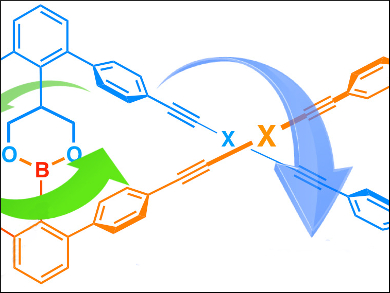Artificial molecular rotors that perform sophisticated rotary motions have attracted considerable interest in the context of molecular machines, particularly because they stand out as essential components for complex machine-like functions in biological systems.
Hiroki Iida, Stephan Irle, Eiji Yashima, and colleagues, Shimane University and Nagoya University, Japan, synthesized organic compounds that form double-stranded helices, covalently bridged by two cyclic boronate esters (structure partially pictured above, X = aromatic spacer unit). The two cyclic boronate ester units encased in the double-stranded helical framework dynamically rotate. Therefore, the double helices function as unprecedented artificial molecular rotors composed of multi-rotators covalently linked to a double helical stator.
The helically twisted stator could also perform an interconvertible helical inversion motion concurrently with the rotation of the cyclic boronate ester units. This provides a molecular rotor that undergoes dual rotary and inverting (twisting) motions. These findings could prove beneficial in developing optically active molecular rotors by introducing chiral substituents on the boronate ester units.
- Double-Stranded Helical Oligomers Covalently-Bridged by Rotary Cyclic Boronate Esters,
Hiroki Iida, Kenji Ohmura, Ryuta Noda, Soichiro Iwahana, Hiroshi Katagiri, Naoki Ousaka, Taku Hayashi, Yuh Hijikata, Stephan Irle, Eiji Yashima,
Chem. Asian J. 2017.
DOI: 10.1002/asia.201700162




